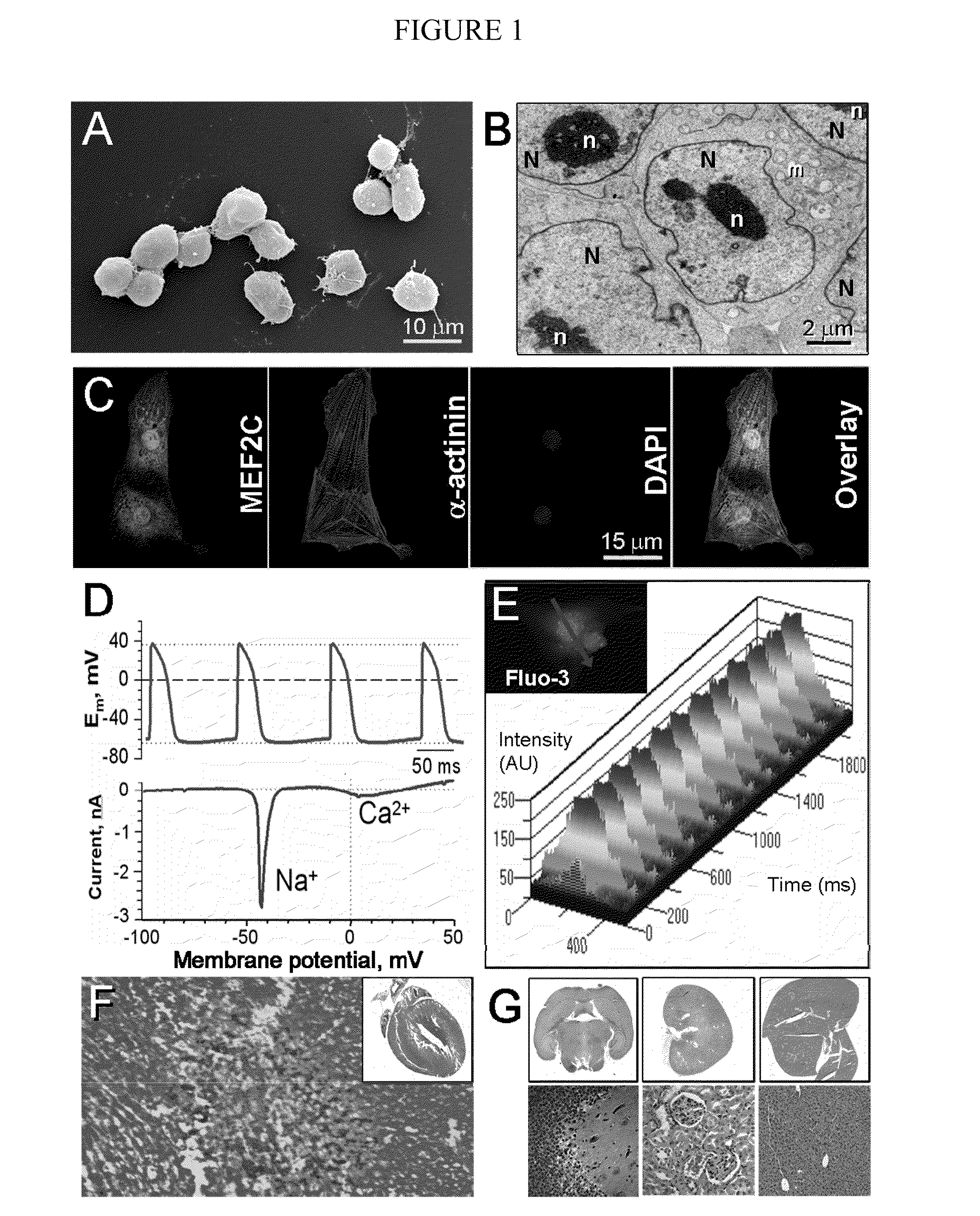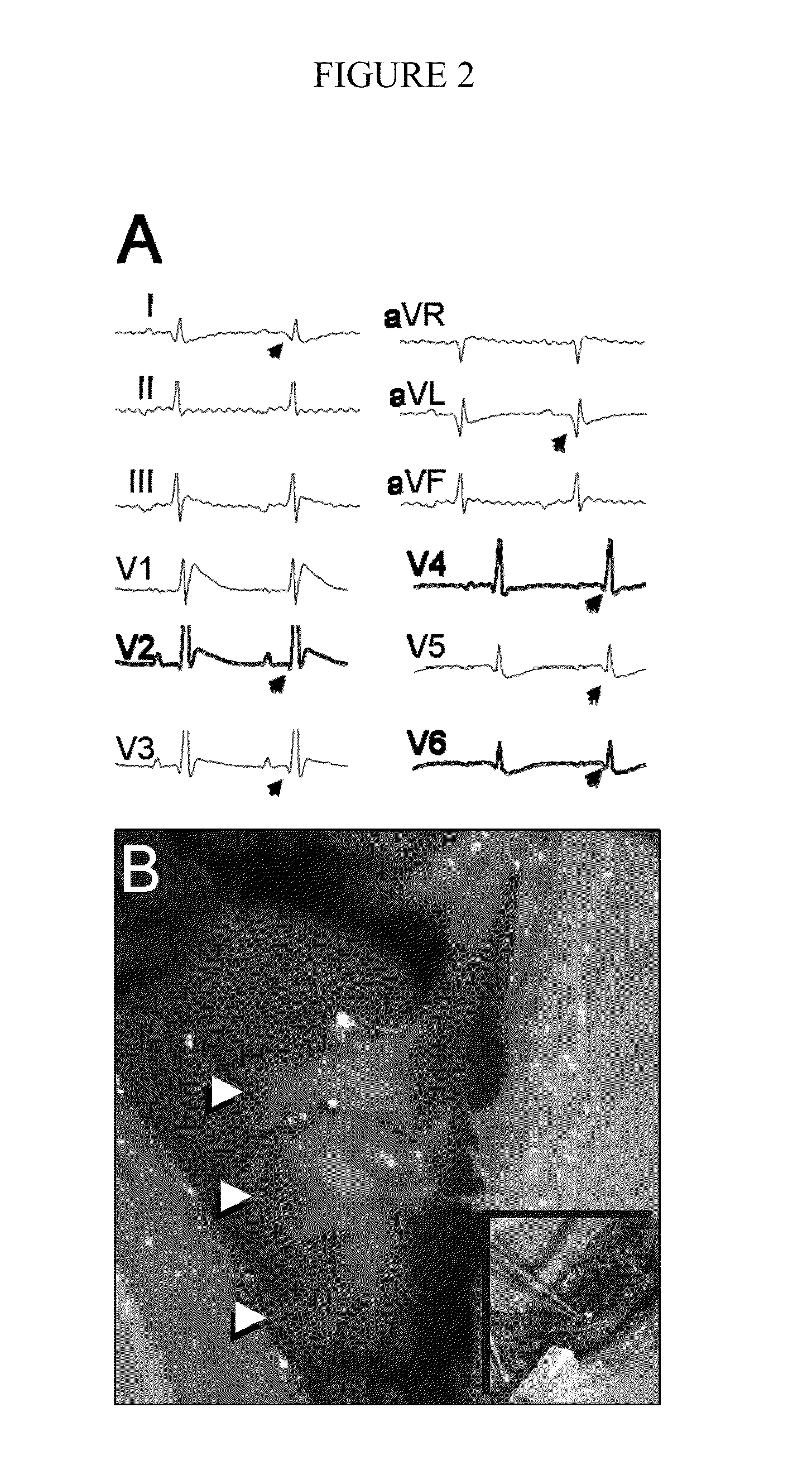Compositions consisting essentially of TGF-β, BMP-2 FGF-4, leukemia inhibitory factor, IGF-1, IL-6 and H-α-thrombin
a technology of tgf- and bmp-2 fgf-4, which is applied in the direction of drug compositions, peptides, cardiovascular disorders, etc., can solve the problems of cardiac remodeling and consequent impairment of myocardial function, impaired myocardial function, and limited mitotic capacity of cardiomyocytes to support adequate myocardial regeneration, etc., to achieve the effect of improving contractile performan
- Summary
- Abstract
- Description
- Claims
- Application Information
AI Technical Summary
Benefits of technology
Problems solved by technology
Method used
Image
Examples
example 1
Materials and Methods for Embryonic Stem Cell Therapy in Myocardial Infarction
[0053]Embryonic stem cells. The CGR8 murine embryonic stem cell line was propagated in BHK21 or Glasgow MEM medium supplemented with pyruvate, non-essential amino acids, mercaptoethanol, 7.5% fetal calf serum, and the leukemia inhibitory factor (Meyer et al., 2000, FEBS Lett., 478:151-158; Perez-Terzic et al., 2003, Circ. Res., 92:444-452). A CGR8 cell clone was engineered to express the yellow fluorescent protein (YFP) or the enhanced cyan fluorescent protein (ECFP) tinder the control of the cardiac-specific α-actin promoter subcloned upstream of ECFP using XhoI and HindIII restriction sites of the promoterless pECFP vector (Clontech). This α-actin promoter construct was linearized using XhoI, and electroporated into CGR8 stem cells as described (Behfar et al., 2002, FASEB J., 16:1558-1566; Meyer et al., 2000, FEBS Lett., 478:151-158). To image stem cells by field-emission scanning electron microscopy, ce...
example 2
Embryonic Stem Cell Therapy in Myocardial Infarction
[0060]Cardiogenic potential of embryonic stem cells and delivery into infarcted heart. The CGR8 embryonic stem cell colony, used herein (FIG. 1A), demonstrated typical features of undifferentiated cells including a high nucleus to cytosol ratio, prominent nucleoli and mitochondria with few cristae (FIG. 1B). The cardiogenic capacity of this embryonic stem cell line was probed by in vitro differentiation, with cells readily derived that express the cardiac transcription factor MEF2C (Lin et al., 1997, Science, 276:1404-1407), the cardiac contractile protein α-actinin and sarcomeric striations (FIG. 1C). Consistent with proper differentiation towards cardiac lineage, stem cell-derived cardiomyocytes demonstrated action potential activity associated with prominent inward Na+ and Ca2+ currents (FIG. 1D), critical for excitation-contraction coupling manifested as rhythmic intracellular Ca2+ transients (FIG. 1E). Injection of CGR8 cells ...
example 3
Materials and Methods for Allogenic Stem Cells Dosed to Secure Cardiogenesis
[0066]Embryonic stem cells and derived cardiomyocytes. Field-emission scanning electron microscopy was used to visualize murine embryonic stem cells in culture (Perez-Terzic et al., 2003, Circ. Res., 92:444-452; Hodgson et al., 2004, Am. J. Physiol., 287:H471-H479). Differentiation in vitro was achieved using the hanging-drop method to generate embryoid bodies from which, following enzymatic dissociation, a highly enriched population of cardiomyocytes was isolated with a density gradient protocol (Behfar et al., 2002, FASEB J., 16:1558-1566; Perez-Terzic et al., 2003, Circ. Res., 92:444-452). Expression of cardiac markers was probed by laser confocal microscopy, with action potential activity captured by the patch-clamp method in the current clamp mode (Hodgson et al., 2004, Am. J. Physiol., 287:H471-H479).
[0067]Stem cell transplantation into host heart. To track transplanted cells in vivo, embryonic stem ce...
PUM
| Property | Measurement | Unit |
|---|---|---|
| pH | aaaaa | aaaaa |
| voltages | aaaaa | aaaaa |
| pH | aaaaa | aaaaa |
Abstract
Description
Claims
Application Information
 Login to View More
Login to View More - R&D
- Intellectual Property
- Life Sciences
- Materials
- Tech Scout
- Unparalleled Data Quality
- Higher Quality Content
- 60% Fewer Hallucinations
Browse by: Latest US Patents, China's latest patents, Technical Efficacy Thesaurus, Application Domain, Technology Topic, Popular Technical Reports.
© 2025 PatSnap. All rights reserved.Legal|Privacy policy|Modern Slavery Act Transparency Statement|Sitemap|About US| Contact US: help@patsnap.com



